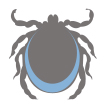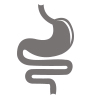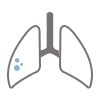AMD: Enhancing Surveillance
Public health agencies use a variety of methods to track disease progression, find the source of outbreaks, and devise ways to keep people safe and healthy. AMD methods, coupled with epidemiologic techniques, are providing a powerful boost to the nation’s disease surveillance system. Genomic sequencing helps us look into the DNA of microbes and discover how they spread through communities, cause illnesses, and become resistant to medications and vaccines designed to stop them. Bioinformatics tools sort through the extensive genomic sequence data and map linkages between pathogens and affected people to help us pinpoint the source of an outbreak. Epidemiologists trained in microbial science use the data from these AMD methods to more rapidly identify and stop diseases in the community.
CDC and state public health laboratories are applying AMD methods to many common public health surveillance questions and developing more robust national and international surveillance systems to protect us from infectious diseases.


Virtually everyone on earth is at risk of becoming ill from bacteria, viruses, and parasites transmitted through the bites of ticks, mosquitoes, and flies, known as vectors. CDC scientists are using AMD methods to trace the range of vector-borne diseases. By using next generation genomic sequencing on pathogens from human samples and vectors, scientists can improve surveillance for known and emerging vector-borne diseases in the United States.
Read more about how AMD is identifying vector-borne diseases.

AMD methods help link bacteria, viruses, and parasites from ill people to food sources contaminated with the same pathogens. Many foodborne diseases have very similar symptoms—diarrhea, stomach cramps, vomiting. To control outbreaks, public health and food safety experts must determine which pathogen is causing the illness and link that pathogen to a food source. Once investigators determine the food source of an outbreak they can take measures, such as issuing a recall of contaminated food, to reduce further infections and save lives. AMD methods are modernizing PulseNet, the nation’s foodborne surveillance laboratory network, with whole genome sequencing for all foodborne pathogens.
Read more about how AMD is fortifying food safety systems.

CDC laboratories, state health departments, and universities collaborate on the nation’s Active Bacterial Core surveillance (ABCs). ABCs is an active laboratory- and population-based surveillance system for invasive bacterial pathogens, such as groups A and B Streptococcus, Streptococcus pneumoniae, Neisseria meningitidis, and Haemophilus influenzae. AMD methods are giving us much more information on the characteristics of these bacteria than conventional methods, including the identification of antimicrobial resistance mechanisms. Using AMD methods, CDC scientists are finding clusters of disease previously missed by epidemiologic and conventional lab testing, which will help us locate and stop the spread of dangerous bacteria.
Read more about how AMD is uncovering emerging threats.

Vaccines have helped eliminate many diseases in the United States, such as polio, but other vaccine-preventable diseases, like pertussis (whooping cough), remain common. With AMD technologies, CDC scientists track mutations that might make pathogens resistant to vaccines that have long helped keep them at bay. For instance, using AMD methods, researchers developed and implemented laboratory techniques for a range of important viral vaccine-preventable diseases, including measles and rubella. In addition, CDC scientists used AMD to confirm that the types of pertussis that cause the most illness in the United States are missing pertactin, one of several components targeted by the pertussis vaccine. Using information gathered through AMD methods, we can track pathogen changes that could make vaccines less effective and inform improved vaccine development.
Read more about how AMD is improving vaccines.

Sometimes the very places where people live, work, or play can expose them to dangerous microbes. For example, Legionella lingering in building cooling systems, hot tubs, or indoor plumbing can cause serious Legionnaires’ disease infections. The fungus Coccidioides that is present in dry, arid environments can cause Valley fever in people who breathe in the fungal spores. And the parasite Cryptosporidium, which easily spreads through drinking and recreational water contaminated with feces. AMD methods are helping CDC identify these dangerous microbes and better understand how they infect people and spread in the environment.
Read more about how AMD is mapping environmental threats.

At any time, 1 of every 25 hospitalized patients gets at least one healthcare-associated infection (HAI). HAIs are infections patients can get while receiving medical treatment. Even more concerning, new antimicrobial-resistant pathogen strains continue to emerge. AMD surveillance methods are helping the U.S. public health system learn more about where pathogens are emerging. For instance, when antimicrobial-resistant Candida auris infections were identified in the U.S. healthcare system for the first time, AMD methods were used to track transmission pathways. This dangerous fungus is difficult to treat and can spread in healthcare facilities where sick people get care. Knowing where these HAIs are emerging helps healthcare settings be on the lookout and use recommended precautions to prevent spread in facilities.
Read more about how AMD is combating healthcare-associated infections.

Infections caused by resistant germs are difficult, and sometimes impossible, to treat. Antibiotic resistance occurs when bacteria develop the ability to defeat the drugs designed to kill them. That means the germs continue to grow and develop resistance. Antibiotic resistance (AR) has the potential to impact all Americans at every stage of life, as well as the healthcare, veterinary, and agricultural industries, making AR one of the world’s most urgent public health problems. Predicting how pathogens will become resistant is a challenge. AMD methods help track emerging and spreading resistance. These methods may one day help us identify antibiotic-resistant infections sooner so healthcare providers can prescribe the most effective medications to treat them.
Read more about how AMD is combating antimicrobial-resistant microbes

CDC, state public health laboratories, and global influenza partners constantly scan for circulating influenza virus strains. Influenza, like most viruses, can mutate rapidly. Genetic data on which influenza strains are circulating help public health professionals determine which viral strains to target in the annual flu vaccine. Scientists are using AMD methods to create influenza laboratory tests that identify strains faster than older methods. CDC scientists helped the three National Influenza Reference Center (NIRC) laboratories get up to speed on a “sequence first” approach to characterize influenza viruses from specimens without culturing the virus beforehand. In addition, CDC and its partners upgraded the national influenza surveillance system to a secure cloud-based platform, which allows scientists to compare strains from various regions sooner and make the best decisions for annual influenza vaccine components.
Read more about how AMD is improving vaccines.

Though the United States eliminated malaria in the 1950s, this parasitic disease spread by mosquitoes remains a deadly global threat. Each year, over 400,000 people die from malaria worldwide. People in the United States become infected with drug-resistant strains of Plasmodium falciparum, one of the malaria-causing parasites, while traveling outside the country. Using AMD methods, scientists have developed next generation sequencing and an automated online surveillance system for detecting early signs of resistance in Plasmodium falciparum genes. CDC is sharing this system with global malaria partners to help us track the spread of drug-resistant strains and provide the best treatment options to patients who may be infected with drug-resistant malaria parasites.
Read more about how AMD is tracking global health.

Each year Americans hear news reports on outbreaks of vomiting and diarrhea caused by norovirus. These outbreaks often occur in places where people are in close quarters, such as healthcare facilities, schools, childcare centers, colleges, prisons, cruise ships, and military encampments. CDC monitors the spread of norovirus strains through CaliciNet, a surveillance network of state and local public health laboratories coordinated by CDC. With AMD methods, CDC is developing a next-generation sequencing (NGS) protocol to identify norovirus genetic material in patient stool samples and greatly improve our ability to detect outbreaks faster.
Read more about how AMD is fortifying food safety systems.

Outbreaks of Mycobacterium tuberculosis (TB) continue to be a challenge in the United States. Knowing which people get TB from the same strain of bacteria helps pinpoint outbreaks that otherwise might be hidden. Using AMD methods, CDC is implementing a national genomic surveillance system. By building AMD capacity at CDC and state laboratories, the public health system can more precisely identify who is part of an outbreak and where to target interventions to ensure the greatest impact and better protect people’s health.
Read more about how AMD is developing faster tests.

Sexually transmitted diseases affect millions of people in the United States. These infections can be spread in many ways, including sexual contact and exposure to bodily fluids of an infected person. CDC scientists are using genetic information for the viruses and bacteria that cause these diseases, together with demographic, geographic, and clinical data—such as risk group, age, location, and health status—to detect rapid spread and understand more about how infected people are connected. Combined, this information helps scientists identify more precisely how these diseases are spreading so that outbreaks can be stopped.
Read more about how AMD is battling HIV.

The majority of people infected with hepatitis C virus (HCV) might not be aware of their infection because they may not have been tested and do not feel sick. And for 70%–85% of people who become infected, HCV becomes chronic or lifelong. Left untreated, HCV infection is a serious disease that can result in long-term health problems, and even death. Through AMD investments, CDC scientists built the Global Hepatitis Outbreak and Surveillance Technology (GHOST), a web-based system that links HCV sequence data to track HCV transmission networks. GHOST harnesses the power of novel bioinformatics technology to perform a comprehensive analysis of hepatitis viruses at the click of a button. GHOST is increasing the rate of detection of HCV transmission in the United States. In addition, we may be able to expand this modern molecular surveillance to other infectious diseases, which could help establish a platform for effective collaboration and communication across the public health system.
Read more about how AMD is battling STDs.